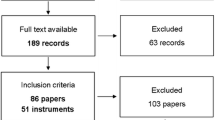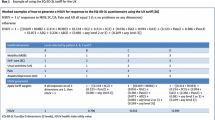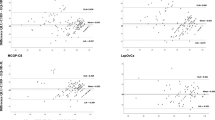Abstract
A condition-specific preference-based measure (CSPBM) is a measure of health-related quality of life (HRQOL) that is specific to a certain condition or disease and that can be used to obtain the quality adjustment weight of the quality-adjusted life-year (QALY) for use in economic models. This article provides an overview of the role and the development of CSPBMs, and presents a description of existing CSPBMs in the literature. The article also provides an overview of the psychometric properties of CSPBMs in comparison with generic preference-based measures (generic PBMs), and considers the advantages and disadvantages of CSPBMs in comparison with generic PBMs. CSPBMs typically include dimensions that are important for that condition but may not be important across all patient groups. There are a large number of CSPBMs across a wide range of conditions, and these vary from covering a wide range of dimensions to more symptomatic or uni-dimensional measures. Psychometric evidence is limited but suggests that CSPBMs offer an advantage in more accurate measurement of milder health states. The mean change and standard deviation can differ for CSPBMs and generic PBMs, and this may impact on incremental cost-effectiveness ratios. CSPBMs have a useful role in HTA where a generic PBM is not appropriate, sensitive or responsive. However, due to issues of comparability across different patient groups and interventions, their usage in health technology assessment is often limited to conditions where it is inappropriate to use a generic PBM or sensitivity analyses.

Modified from Brazier et al. [1]
Similar content being viewed by others
References
Brazier JE, et al. Developing and testing methods for deriving preference-based measures of health from condition-specific measures (and other patient-based measures of outcome). Health Technol Assess. 2012;16(32):1–113.
Rowen D, et al. Deriving a preference-based measure for cancer using the EORTC QLQ-C30. Value Health. 2011;14(5):721–31.
Young TA, et al. Developing preference-based health measures: using Rasch analysis to generate health state values. Qual Life Res. 2010;19(6):907–17.
Lloyd A, et al. Health-related quality of life and health utilities in metastatic castrate-resistant prostate cancer: a survey capturing experiences from a diverse sample of UK patients. Value Health. 2015;18:1152–7.
Young T, et al. The first stage of developing preference-based measures: constructing a health-state classification using Rasch analysis. Qual Life Res. 2009;18(2):253–65.
Stevens KJ, et al. The development of a preference-based measure of health in children with atopic dermatitis. Br J Dermatol. 2005;153(2):372–7.
Rasch G. Probabilistic models for some intelligence and attainment tests. Chicago: University of Chicago Press; 1960.
Tesio L. Measuring behaviours and perceptions: Rasch analysis as a tool for rehabilitation research. J Rehabil Med. 2003;35(3):105–15.
Mavranezouli I, et al. Estimating a preference-based index from the clinical outcomes in routine evaluation-outcome measure (CORE-OM): valuation of CORE-6D. Med Decis Mak. 2013;33(3):381–95.
King MT, Costa DSJ, Aaronson NK, Brazier JE, Cella DF, Fayers PM, Grimison P, Janda M, Kemmler G, Norman R, Pickard AS, Rowen D, Velikova G, Young TA, Viney R. QLU-C10D: a health state classification system for a multi-attribute utility measure based on the EORTC QLQ-C30. Qual. Life Res. 2016;25(3):625–36.
Mukuria C, et al. Deriving a preference-based measure for myelofibrosis from the EORTC QLQ-C30 and the MF-SAF. Value Health J Int Soc Pharmacoecon Outcomes Res. 2015;18(6):846–55.
(FDA), U.D.o.H.a.H.S.F.a.D.A. Guidance for industry: patient-reported outcome measures: use in medical product development to support labeling claims. Maryland: FDA; 2009.
Palfreyman S. The SPVU-5D: a preference-based measure of health related quality of life for use with venous leg ulceration. PRO Newsletter, 2012 (45 (Spring Issue)).
Goodwin E, Green C. A systematic review of the literature on the development of condition-specific preference-based measures of health. Appl Health Econ Health Policy. 2016;14:161–83.
Beusterien K, et al. Integrating preferences into health status assessment for amyotrophic lateral sclerosis: the ALS Utility Index. Amyotroph Lateral Scler Other Motor Neuron Disord. 2005;6(3):169–76.
Versteegh MM et al. Condition-specific preference-based measures: benefit or burden? Value Health. 2012 (Forthcoming).
Young T, et al. The use of rasch analysis in reducing a large condition-specific instrument for preference valuation: the case of moving from AQLQ to AQL-5D. Med Decis Mak. 2011;31(1):195–210.
Yang Y, et al. Estimating a preference-based index for a 5-dimensional health state classification for asthma derived from the Asthma Quality of Life Questionnaire. Med Decis Mak. 2011;31:281–91.
Norman R, Viney R, Aaronson NK, Brazier JE, Cella D, Costa DSJ, Fayers PM, Kemmler G, Peacock S, Pickard AS, Rowen D, Street D, Velikova G, Young TA, King MT. Using a discrete choice experiment to value the QLU-C10D: feasibility and sensitivity to presentation format. Qual. Life Res. 2016;25(3):637–49.
Kularatna S, et al. Development of an EORTC-8D utility algorithm for Sri Lanka. Med Decis Mak. 2015;35(3):361–70.
Petrillo J, Cairns J. Development of the EXACT-U: a preference-based measure to report COPD exacerbation utilities. Value Health. 2011;14:546–54.
Mavranezouli I, et al. Using Rasch analysis to form plausible health states amenable to valuation: the development of the CORE-6D from a measure of common mental health problems (CORE-OM). Qual Life Res. 2011;20(3):321–33.
Rowen D, et al. Estimating preference-based single index measures for dementia using DEMQOL and DEMQOL-Proxy. Value Health. 2012;15:346–56.
Mulhern B, et al. Improving the measurement of QALYs in Dementia: developing patient- and carer-reported health state classification systems using Rasch analysis. Value Health. 2012;15:323–33.
Mulhern B, Rowen D, Brazier J, Smith S, Romeo R. Development of DEMQOL-U and DEMQOL-PROXY-U: generation of preference-based indices from DEMQOL and DEMQOL-PROXY for use in economic evaluation. Health Technol Assess. 2013;17(5).
Sundaram M, et al. Estimation of a valuation function for a diabetes mellitus-specific preference-based measure of health the diabetes utility index (R). Pharmacoeconomics. 2010;28(3):201–16.
Sundaram M, et al. Rasch analysis informed the development of a classification system for a diabetes-specific preference-based measure of health. J Clin Epidemiol. 2009;62(8):845–56.
Mulhern B, et al. The development of a QALY measure for epilepsy: NEWQOL-6D. Epilepsy Behav E&B. 2012;24(1):36–43.
Stolk EA, Busschbach J. Validity and feasibility of the use of condition-specific outcome measures in economic evaluation. Qual Life Res. 2003;12(4):363–71.
Kerr C, et al. Developing a utility index for the Aberrant behavior checklist (ABC-C) for fragile X syndrome. Qual Life Res. 2015;24:305–14.
Kind P, Macran S. Eliciting social preference weights for functional assessment of cancer therapy-lung health states. PharmacoEconomics. 2005;23(11):1143–53.
Lamers LM, Uyl-de Groot CA, Buijt I. The use of disease-specific outcome measures in cost-utility analysis: The development of Dutch societal preference weights for the FACT-L scale. PharmacoEconomics. 2007;25(7):591–603.
Brazier JE, et al. Estimating a preference-based index for a menopause specific health quality of life questionnaire. Health Qual. Life Outcomes. 2005;3:13.
Yang Y, et al. Estimating a preference-based single index from the overactive bladder questionnaire. Value Health. 2009;12(1):159–66.
Choiu CF, et al. Development of the multi-attribute Paediatric Asthma Health Outcome Measure (PAHOM). Int J Qual Health Care. 2005;17(1):23–30.
Palmer CS, et al. Patient preferences and utilities for ‘off-time’ outcomes in the treatment of Parkinson’s disease. Qual Life Res. 2000;9(7):819–27.
Tomlinson G, et al. Development and validation of a utility weighting function for the patient-oriented prostate utility scale (PORPUS). Med Decis Mak. 2012;32(1):11–30.
Krahn MR. Construction of the Patient-Oriented Prostate Utility Scale (PORPUS): A multiattribute health state classification system for prostate cancer. J Clin Epidemiol. 2000;53(9):920–30.
McKenna SP, et al. Development and validation of a preference based measure derived from the Cambridge Pulmonary Hypertension Outcome Review (CAMPHOR) for use in cost utility analyses. Health Qual Life Outcomes. 2008;6:65.
Montejo AL, et al. Estimation of a multiattribute utility function for the Spanish Version of the TooL Questionnaire. Value Health. 2011;14:564–70.
Bharmal M, Thomas J. Comparing the EQ-5D and the SF-6D descriptive systems to assess their ceiling effects in the us general population. Value Health. 2006;9(4):262–71.
Finger RP, et al. Evaluation of a vision-related utility instrument: the German Vision and Quality of Life Index. Invest Ophthalmol Vis Sci. 2013;54:1289–94.
Desroziers K, et al. Estimating EQ-5D and OAB-5D health state utilities for patients with overactive bladder. Health Qual Life Outcomes. 2013;11:9.
McTaggart-Cowan HM, et al. The validity of generic and condition-specific preference-based instruments: the ability to discriminate asthma control status. Qual Life Res. 2008;17(3):453–62.
Hatswell AJ, Pennington B, Pericleous L, Rowen D, Lebmeier M, Lee D. Patient-reported utilities in advanced or metastatic melanoma, including analysis of utilities by time to death. Health Qual Life Outcomes. 2014;12(1):140.
Wolowacz S, et al. Estimating health-state utility for economic models in clinical studies: an ISPOR good research practices task force report. Value Health. 2016;19:704–19.
Brazier J, et al. A review of generic preference-based measures for use in cost-effectiveness models. PharmacoEconomics. 2017. doi:10.1007/s40273-017-0545-x.
Rowen D, et al. It’s all in the name, or is it? The impact of labelling on health state values. Med Decis Mak. 2012;32(1):31–40.
NICE; National Institute of Health and Care Excellence. Guide to the methods of technology appraisal. London: NICE; 2013.
Longworth L, et al. Use of generic and condition-specific measures of health-related quality of life in NICE decision-making: a systematic review, statistical modelling and survey. Health Technol Assess. 2014;18(9):1–224.
Brazier J, Tsuchiya A. Preference-based condition-specific measures of health: what happens to cross programme comparability? Health Econ. 2010;19:125–9.
Rowen D, et al. International regulations and recommendations for utility data for health technology assessment. PharmacoEconomics. 2017. doi:10.1007/s40273-017-0544-y.
Scholzel-Dorenbos CJM, et al. Validation study of the prototype of a disease-specific index measure for health-related quality of life in dementia. Health Qual Life Outcomes. 2012;10:11.
Arons AMM, et al. A simple and practical index to measure dementia-related quality of life. Value Health. 2016;19:60–5.
Goodwin E, Green C. A quality-adjusted life-year measure for multiple sclerosis: developing a patient-reported health state classification system for a multiple sclerosis-specific preference-based measure. Value Health J Int Soc Pharmacoecon Outcomes Res. 2015;18(8):1016–24.
Ratcliffe J, et al. Using DCE and ranking data to estimate cardinal values for health states for deriving a preference-based single index from the sexual quality of life questionnaire. Health Econ. 2009;18(11):1261–76.
LLoyd A, et al. Economic evaluation in short bowel syndrome (SBS): an algorithm to estimate utility scores for a patient-reported SBS-specific quality of life scale (SBS-QoL(TM)). Qual Life Res. 2014;23:449–58.
Brazier JE, et al. Estimation of a preference-based index from a condition-specific measure: the King’s health questionnaire. Med Decis Mak. 2008;28(1):113–26.
Cuervo J, et al. Development of the Incontinence Utility Index: estimating population-based utilities associated with urinary problems from the Incontinence Quality of Life Questionnaire and Neurogenic Module. Health Qual Life Outcomes. 2014;12:147.
Kok ET, et al. The valuation of the International Prostate Symptom Score (IPSS) for use in economic evaluations. Eur Urol. 2002;42:491–7.
Misajon R, et al. Vision and quality of life: the development of a utility measure. Invest Ophthalmol Vis Sci. 2005;46(11):4007–15.
Kowalski JW, et al. Rasch analysis in the development of a simplified version of the national eye institute visual-function questionnaire-25 for utility estimation. Qual Life Res. 2011 (Forthcoming).
Rowen D, Brazier JE. Multi-attribute utility instruments: condition-specific versions. In: Culyer AJ, editor. Encyclopaedia of health economics. San Diego: Elsevier; 2014. P. 358–365.
Yang Y, et al. Estimating a preference-based index for a 5-dimensional health state classification for asthma derived from the asthma quality of life questionnaire. Med Dec Mak. 2011;31(2):281–91.
Rowen D, et al. Estimating preference-based single index measures for dementia using DEMQOL and DEMQOL-Proxy. Value Health J Int Soc Pharmacoecon Outcomes Res. 2012;15(2):346–56.
Peacock S, et al. Vision and quality of life: development of methods for the VisQoL vision-related utility instrument. Ophthalmic Epidemiol. 2008;15(4):218–23.
Rentz AM, et al. Development of a preference-based index from the national eye institute visual function questionnaire-25. JAMA Ophthalmol. 2014;132:310–8.
Acknowledgements
The authors would like to thank Prof. Jon Karnon, PhD, of The University of Adelaide and Dr Andrew Lloyd, PhD, of Bladen Associates Ltd for their editorial review.
Author information
Authors and Affiliations
Contributions
DR reviewed the literature and wrote the first draft of the manuscript and subsequent versions. JEB, RA and IA contributed to draft and final versions of the manuscript.
Corresponding author
Ethics declarations
Funding
This study was funded by an unrestricted grant from Takeda Pharmaceuticals International AG.
Conflict of interest
Ismail Azzabi Zouraq is employed by Takeda Pharmaceuticals International AG. Donna Rowen, John Brazier and Roberta Ara have no conflicts of interest.
Disclosure statement
This article is published in a special edition journal supplement wholly funded by Takeda Pharmaceutical International AG, Zurich, Switzerland.
Electronic supplementary material
Below is the link to the electronic supplementary material.
Rights and permissions
About this article
Cite this article
Rowen, D., Brazier, J., Ara, R. et al. The Role of Condition-Specific Preference-Based Measures in Health Technology Assessment. PharmacoEconomics 35 (Suppl 1), 33–41 (2017). https://doi.org/10.1007/s40273-017-0546-9
Published:
Issue Date:
DOI: https://doi.org/10.1007/s40273-017-0546-9




